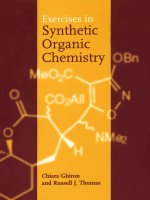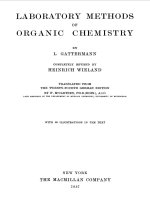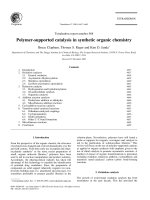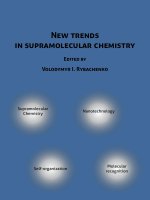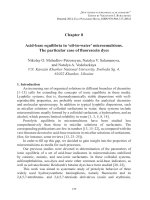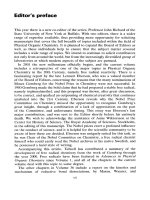Progress in physical organic chemistry volume 19
Bạn đang xem bản rút gọn của tài liệu. Xem và tải ngay bản đầy đủ của tài liệu tại đây (20.84 MB, 356 trang )
Progress in
PHYSICAL
ORGANIC
CHEMISTRY
VOLUME 19
www.pdfgrip.com
Progress in
PHYSICAL
ORGANIC
CHEMISTRY
VOLUME 19
Editor
ROBERT W. TAFT, Department of Chemistry
University of Calqornia, lrvine, California
A Wiley-Interscience Publication
John Wiley & Sons, Inc.
New York / Chichester
/ Brisbane / Toronto / Singapore
www.pdfgrip.com
This text is printed on acid-free paper.
An Interscience* Publication
Copyright 0 1993 by John Wiley & Sons, Inc.
All rights reserved. Published simultaneously in Canada.
Reproduction or translation of any part of this work
beyond that permitted by Section 107 or 108 of the
1976 United States Copyright Act without the permission
of the copyright owner is unlawful. Requests for
permission or further information should be addressed to
the Permissions Department, John Wiley & Sons, Inc.
Libraty of Congress Cataloging in Publication m a :
Library of Congress Catalog Card Number: 63-19364
ISBN 0-471-52442-5
Printed in the United States of America
1 0 9 8 7 6 5 4 3 2 1
www.pdfgrip.com
Contributors to Volume 19
Jose-Luis M. Abboud
Instituto de Quimica Fisica “Rocasolano”
CSIC
Madrid, Spain
Juan Bertran
Department de Quimica
Universitat Autbnoma de Barcelona
Bellaterra (Catalonia), Spain
Keith Bowden
Department of Chemistry and Biological Chemistry
University of Essex
Colchester, Essex, U.K.
Erwin Buncel
Department of Chemistry
Queen’s University
Kingston, Canada
Ulf Edlund
Department of Organic Chemistry
UmeA University
Ume& Sweden
Otto Exner
Institute of Organic Chemistry and Biochemistry
Czechoslovak Academy of Sciences
Prague, Czechoslovakia
Zdenkk Fried1
Institute of Organic Chemistry and Biochemistry
Czechoslovak Academy of Sciences
Prague, Czechoslovakia
V
www.pdfgrip.com
vi
CONTRIBUTORS TO VOLUME 19
Edward J. Grubbs
Department of Chemistry
San Diego State University
San Diego, California
Mortimer J. Kamlet
Deceased
Rafael Notario
Instituto de Quimica Fisica “Rocasolano”
CSIC
Madrid, Spain
Miquel Sola
Department de Quimica
Universitat AutBnoma de Barcelona
Bellaterra (Catalonia), Spain
Tessek Laboratory
Institute of Analytical Chemistry
Czechoslovak Academy of Sciences
Brno. Czechoslovakia
www.pdfgrip.com
Introduction to the Series
Physical organic chemistry is a relatively modern field with deep roots
in chemistry. The subject is concerned with investigations of organic chemistry by quantitative and mathematical methods. The wedding of physical
and organic chemistry has provided a remarkable source of inspiration for
both of these classical areas of chemical endeavor. Further, the potential for
new developments resulting from this union appears to be still greater. A
closing of ties with all aspects of molecular structure and spectroscopy is
clearly anticipated. The field provides the proving ground for the development of basic tools for investigations in the areas of molecular biology and
biophysics. The subject has an inherent association with phenomena in the
condensed phase and thereby with the theories of this state of matter.
The chief directions of the field are: (a) the effects of structure and environment on reaction rates and equilibria; (b) mechanisms of reactions; and
(c) applications of statistical and quantum mechanics to organic compounds
and reactions. Taken broadly, of course, much of chemistry lies within these
confines. The dominant theme that characterizes this field is the emphasis
on interpretation and understanding which permits the effective practice of
organic chemistry. The field gains its momentum from the application of
basic theories and methods of physical chemistry to the broad areas of
knowledge of organic reactions and organic structural theory. The nearly
inexhaustible diversity of organic structures permits detailed and systematic
investigations which have no peer. The reactions of complex natural products
have contributed to the development of theories ofphysical organic chemistry,
and, in turn, these theories have ultimately provided great aid in the elucidation of structures of natural products.
Fundamental advances are offered by the knowledge of energy states
and their electronic distributions in organic compounds and the relationship
of these reaction mechanisms. The development, for example, of enen an
empirical and approximate general scheme for the estimation of activation
energies would indeed by most notable.
The complexity of even the simplest organic compounds in terms of
physical theory well endows the field of physical organic chemistry with the
frustrations of approximations. The quantitative correlations employed in
this field vary from purely empirical operational formulations to the approach
of applying physical principles to a workable model. The most common
vii
www.pdfgrip.com
...
Vlll
INTRODUCTION TO THE SERIES
procedures have involved the application of approximate theories to approximate models. Critical assessment of the scope and limitations of these
approximate applications of theory leads to further development and
understanding.
Although he may wish to be a disclaimer, the physical organic chemist
attempts to compensate his lack of physical regor by the vigor of his efforts.
There has indeed been recently a great outpouring of work in this field. We
believe that a forum for exchange of views and for critical and authoritative
reviews of topics is an essential need of this field. It is our hope that the
projected periodical series of volumes under this title will help serve this
need. The general organization and character of the scholarly presentations
of our series will correspond to that of the several prototypes, e g , Advances
in Enzymology, Advances in Chemical Physics, and Progress in Inorganic
Chemistry.
We have encouraged the authors to review topics in a style that is not
only somewhat more speculative in character but which is also more detailed
than presentations normally found in textbooks. Appropriate to this quantitative aspect of organic chemistry, authors have also been encouraged in the
citation of numerical data. I t is intended that these volumes will find wide
use among graduate students as well as practicing organic chemists who are
not necessarily expert in the field of these special topics. Aside from these
rather obvious considerations, the emphasis in each chapter is the personal
ideas of the author. We wish to express our gratitude to the authors for the
excellence of their individual presentations.
We greatly welcome comments and suggestions on any aspect of these
volumes.
Robert W . Tuft
www.pdfgrip.com
Contents
h e Century of Physical Organic Chemistry: The Menshutkin
Reaction
By Jose-Luis M . Abboud, Rafael Notario, Juan Bertran, and
Miquel Sold
4ngular Dependence of Dipolar Substituent Effects
By Keith Bowden and Edward J . Grubbs
1
183
3lectronic Configuration, Structure, and Solvation of PhenylSubstituted Group 4 Anions
By UlfEdlund and Erwin Buncel
225
rransmission of Substituent Effects: The Through-Space and
Through-Bond Models and Their Experimental Verification
By Otto Exner, Zdenik Friedl, and Tessek Laboratory
259
Linear Solvation Energy Relationships: An Improved Equation for
Correlation and Prediction of Aqueous Solubilitiesof Aromatic
Solutes Including Polycyclic Aromatic Hydrocarbons and
Polychlorinated Biphenyls
By Mortimer J . Kamlet
295
iuthor Index
319
iubject Index
343
kmulative Index, Volume 1-19
345
ix
www.pdfgrip.com
Progress in Physical Organic C h e m i s e , Volume 19
Edited by Robert W. Taft
Copyright 0 1993 by John Wiley & Sons, Inc.
One Century of Physical Organic Chemistry:
The Menshutkin Reaction
M. ABBOUDAND RAFAELNOTARIO
Instituto de Quimica Fisica “Rocasolano, CSIC
Madrid, Spain
BY JOSE-LUIS
”
JUANBERTRAN AND MIQUELSOLA
Departament d e Quimica
Universitat Autdnoma de Barcelona
Bellaterra (Catalonia), Spain
CONTENTS
I. Menshutkin and the Menshutkin Reaction 1
11. Thermodynamic Features of the Menshutkin Reaction
111. Kinetics of the Menshutkin Reaction 11
3
A. The Database and Its Analysis 11
B. The Role of the Nucleophile 13
1. Taft-Topsom Analyses 13
2. Br$nsted Analyses 22
3. Special Cases 27
C . The Role of the Electrophile (RL) 28
1. Influence of the Substrate (R) 28
2. Influence of the Nucleofuge 38
3. Interaction Terms 42
D. Solvent and Other Catalytic Effects 46
1. General Features 46
2. Catalysis by Electric Fields ‘47
3. Magnitudes of Transfer 49
4. Cavity Effects 50
5. Empirical Analyses 51
6. MRs in Mixed Solvents 52
7. Interaction ENects 57
E. Pressure Effects 59
1. Charge Separation within the TS 60
2. The Dissection of AV6 61
3. Interaction Effects 63
F. Isotope Effects (IEs) 64
1. Primary KIEs 65
2. Secondary KIEs 67
1
www.pdfgrip.com
2
J.-L. M. ABBOUD, R. NOTARIO,J. BERTRAN, AND M. SOLA
IV. Quantum-Mechanical Approach 70
A. S,2 Reactions 70
1 . Gas-Phase Studies 70
2. Solvation Effects 72
3. SN2 Reactions Involving Cations 77
B. Menshutkin Reaction 79
1. Gas-Phase Results 80
2. Solvent Effects 82
V. Overview 89
Acknowledgments 90
References and Notes 90
Appendix I. Primary Sources of Kinetic Data 104
Appendix 11. Reviews on the Menshutkin Reaction 182
A. General Reviews 182
B. Reviews on Specific Topics 182
1. Structural Effects 182
2. Solvent Effects 182
3. Pressure Effects 182
4. Isotope Effects and Mechanism 182
I. MENSHUTKIN (1,2) AND THE MENSHUTKIN
REACTION
Born October 24, 1842, Nikolai Alexandrovich Menshutkin (3) spent
most of his academic life at the University of Saint Petersburg, where he
graduated in 1862.
Together with Butlerov and Mendeleiev, he was one of the founding
fathers of the Russian Chemical Society (1869). He became the first editor
of the Journal of the Russian Chemical Society, soon to be renamed the
Journal of the Russiun Physical and Chemical Societies. He held this post
until 1900.
From 1902 until the time of his death on February 5, 1907, he occupied
the chair of Analytical and Organic Chemistry at the then newly created
Polytechnic Institute of Saint Petersburg. In this respect, it is of interest that
his book Analytical Chemistry enjoyed a worldwide reputation.
His paper “Uber die Affnitatkoeffzienten der Alkylhaloide und der
Amine” was published in 1890 (4). At that time, the quaternization of amines
was already known for several decades (5). Also known was that the rate
constants of reactions taking place in solution are often solvent-dependent
(6). However, Menshutkin’s treatment of solvent effects on the second-order
rate constant for the quaternization of triethylamine with ethyl iodide
(Reaction 1) at 100°C
(C,H,),N
+ C,H,J
-
(C2H=J4N+I-
www.pdfgrip.com
PHYSICAL ORGANIC CHEMISTRY: THE MENSHUTKIN REACTION
3
was probably the first systematic study in this field of physical organic
chemistry. He was aware of the importance of his findings (7).
During 1877-1905 he published a number of papers dealing with
structural and medium effects on reactivity (see Appendix I). They are
“modern” in many respects, and most of his data are still valid. Clearly,
Nikolai Alexandrovich Menshutkin was “avant la lettre,” a quite brilliant
physical organic chemist.
The IUPAC defines (2) the Menshutkin reaction (MR) as the trialkylammonio-dehalogenation of alkyl halides:
Following the common practice we shall adopt here a somewhat broader
definition, encompassing all sN2 [or ANDN (8)] alkylation reactions of
nitrogen bases in which the formal hybridization of the nitrogen atom is sp2
or sp3, with no restrictions imposed on the nature of the nucleofuge. In
keeping with the spirit of the IUPAC definition, attention will be focused
primarily on neutral electrophiles.
This review is organized as follows. In Sections II and I11 we examine the
thermodynamic and kinetic data available thus far. A quantum-mechanical
approach to the MR is given in Section IV. Relevant conclusions and prospects are summarized in Section V.
11. THERMODYNAMIC FEATURES OF THE
MENSHUTKIN REACTION
All the experimental evidence seems to indicate that “gas-phase’’ MRs
actually take place on the walls of the reaction vessel and/or on the solid salt
(9). Quantitative studies on the systems Me,N(g)/MeI(g) (10) and Et,N(g)/
MeI(g) (1 1 ) show that actioation energies are negative and that the addition
of gaseous dipolar materials has little effect on reaction rates.
In solution, the reversibility of MRs involving halides has long been
known (12).
Consider the reaction between a nitrogen base B and an alkylating
reagent RL (in principle, L is any nucleofuge) in any solvent:
B + RL eBR+ + L separate ions
eBR+L- I BR’Lion pairs
(3)
solid salt
In the general case, products appear as separate ions, ion pairs (13), and
solid salt.
www.pdfgrip.com
4
LL. M. ABBOUD, R. NOTARIO,J . BERTRAN, AND M. SOLA
The situation is greatly simplified by using highly dilute solutions of the
reagents in solvents able to strongly solvate the ionic products:
kf
B+RLeBR++Lk.
K,
(4)
In this case, both k, and k , can be obtained directly (14) from separate
studies of the forward and reverse reactions. In some instances, both kf and
k , can be obtained by simultaneously monitoring the concentrations of
reactants in systems containing initially B, RL, and S alone (15). This method
entails larger uncertainties (16).
Notice that Kc, the equilibrium constant for Reaction 4, equals k,/k,.
The Lewis concept of acids and bases links proton exchange to exchanges
of other electron-accepting species (17):
+ B, eB, + B2Ht
B , R + + B, F= B, + B2Rf
B,BF3 + B, @ B, + B,BF3
B,H+
AAH;., K , ,
(5)
AAH;+, K,,
(6)
AAHiF3,KBF3
(7)
The relationship between the MR and alkyl cation exchange between two
bases, B, and B,, follows from the consideration of simultaneous equilibria
(4) for B, and B,:
Alkyl cation exchange can be observed experimentally (1 8). This provides
a direct measure of K , + .
Relevant thermodynamic data for Reactions 5 and 7 are collected in
Table 1 , wherein pyridine has been chosen as the reference base B,.
Figure 1 shows that, for a given base, differential methyl cation affinities
(26),AAHLe+,are essentially independent of the solvent (27)(NB = C,H,N02;
SU = sulfolane; 2NP = 2-nitropropane). This is probably a consequence of
the small range of dielectric constants spanned by these solvents; AAHG, +(NB)
is quite comparable to AAHi,+(2NP)(28).
Relevant relationships between AAHLe+(NB)and other thermodynamic
data are as follows:
1. As shown in Fig. 2, AAHL,+(NB) and AAHiF3(CH,Cl2)(differential
BF3 affinities) for 3- and 4-substituted pyridines are linearly related (14),(17).
VI
f0.35'
- 1.32 f0.26'
-
-
- 5.6'
-
- 9.7'
- 5.4f
-
+
+
- 3.7'
- 1.46 & 0.29'
- 1.49 f 0.49'
- 1.75 f 0.50'
- 1.07'
-0.78 f0.26'
(0.0)
3.99 0.36'
4.74e
4.91 i 1.10''
5.19'
3.39'
8.1 1 f0.70"
0.50 0.46'
-
-
-
-
-
-
-
-
-
-
-
-
-
6.60 f0.38'
5.06 f0.12'
4.16 & 0.06'
7.1 1 f 0.33'
-
-
-
-
4.44'
6.47 f 0.07'
7.61 k0.11'
-5.25 f O.lOh
-
(0.0)
2.22 f0.10'
2.95 & 0.10'
3.54 f0.10'
2.39 f0.14'
-1.45f0.15'
-0.68 f0.10'
-
-1.40+0.12'
-5.6Ih
- 1.72 f0.10'
hRef. 21.
'Ref. 22.
'Estimated value (see Fig. 2).
'Ref. 23.
'Estimated assuming the additivity of substituent effects.
"Ref. 24.
"Ref. 25.
5.36 f0.12'
3.31 f 0.06'
7.72 f0.61'
10.68 f0.62'
-8.91'
-4.579
- 5.409
- 5.67'
5.50g
4.80 f0.38'
5.36 f0.12'
3.31 f0.06'
7.40 f0.33'
-
(0.0)
4.09 f0.32'
(0.0)
4.19 f0.44'
__
-
-
-
+
-
-
-
(0.0)
5.07 f 0.44'
-
-
- 1.16 0.39'
-
-
- 3.70'
-
-
'Ref. 19.
'Ref. 14.
'Calculated through linear relationships between values of AHie
determined in nitrobenzene and in other solvents.
Ref. 18.
'Ref. 20.
1,4-diazabicyclo[2.2.2]octane.
l.
-
-
-
7.59 f 0.57'
0.84 f0.26'
10.54 f0.72'
-9.21 fO.24'
-
(0.0)
3.95 f0.24'
4.48 f0.15'
4.61 f0.46'
4.91 f0.26'
-
- 2.40
"All values in kcal mol-
X-Pyridines
4-NMe2
4-OMe
4-ter-C4-H,
4-Me
3-Me
3,5-Me,
H
3-CI
4-CF3
4-CN
3-Br
3-F
3,5-C12
2,4,6-Me,
2-CI
Quinuclidine
N-Me-piperidine
Et3N
DABCOb
TABLE 1
Thermodynamic Data for Reactions 5-7"
(0.0)
3.3k
3.4'
4.6'
3.9"
3.0"
6.3'
6.1'
- 7.7"
- 6.7*
- 7.5'
-4.8'
- 6.P
- 1.9'
0.6'
- 1.1'
-0.5'
-
www.pdfgrip.com
www.pdfgrip.com
6
J.-L. M. ABBOUD, R. NOTARIO, J. BERTRAN, AND M. SOLA
Ah H&eJKcal.mol-’
12.0
)
Various solvents
10.0 -
80 -
6.0 40
-
-A@
-30
-10
00
20
40
60
sulfolane
2-nitropropane
acetonitrite
80
100
120
Figure I Differential methyl cation affinities for nitrogen bases (relative t o pyridine) in various
solvents versus the correspondent values in nitrobenzene solution.
Figure 2 Differential methyl cation a h i t i e s AA&
(NB) versus differential standard enthalpy
changes for RCdction 6 in CH,CI,. Reference base is pyridine.
www.pdfgrip.com
PHYSICAL ORGANIC CHEMISTRY: THE MENSHUTKIN REAGTION
I
This does not apply to pyridines bearing electron-releasing ( - R) substituents, indicating significant differences between Reactions 6 and 7 in terms of
electron demand and, more likely, solvation.
2. Likewise, AAHMe+(NB)and AAGi+(aq)values (14,17) for the same
substituents follow
AAGi+(aq)= (- 0.34 f0.38) + (1.32 _+ O.12)AAHGe+(NB)
(9)
where n = 10; r2 = .986; sd = 0.43 kcal mol-'.
It is known that polarizability contributions to AAH&JCH,Cl,) (21) and
AAGi+(aq)(23)are small, and it follows that the same holds for AAHMe+(NB).
A wealth of kinetic data for forward and reverse alkylation reactions of
pyridines and other heterocycles is available (29), indicating that they should
provide reliable AAGie+ values. Their usefulness for this purpose is, unfortunately, limited by the fact that they are obtained using very different temperatures and solvents.
Standard free-energy changes for the alkylation of N,N-dimethylanilines(30) [AGGA,Reaction lo] and pyridines (14) [AG;,, Reaction 111 with
Me1 under formal conditions of equilibrium are presented in Table 2.
+
XC6H4NMe2 Me1 -+ XC6H4hhde31- (ion pairs)
XC,H4N
+ Me1 +XC5H4NMe+ + I -
(separate ions)
(10)
(1 1)
For a given substituent X, AG;, is strongly solvent-dependent (30b, 3 1).
This can be analyzed through the following cycle (32):
Solvent S,
1I
AG;
B+RX
AGf;(B)
Solvent S,
B+RX
[AG:,(RX)
A$
[(BR)+X-],,
1
AG :,(product)
"Free" ions
and/or
ion pairs
[(BR+)X-],,
in which the "product" appears as "free" ions or ion pairs. For any species,
AC,., is the corresponding standard free- energy change for the transfer from
solvent S, into solvent S,. Equation 12 follows:
AG;
-
AGY = AG,"(product) - [AG,"(RL)
+ AG,",(B)]
(12)
In the absence of strong solvent-solute interactions (such as hydrogen
m
AGG,(NB)
- 0.4b
-4.6b
- 3 S b (- 3.3)'
- 2.8' (- 2.8)'
1.5
-
-
- 3.5
- 2.9
-2.5
- 0.2
-
-
1.6
AGLA(C6H6)'
AGG,(Me,CO)'
0.0
0.5
0.9
-
-
AGk,(THF)b
"Allvalues in kcal mol- I. Values for Reaction 10 determinedat 60°C;those for Reaction 11, at 25°C.
bFrom Ref. 30b.
'From Ref. 30a.
dFrorn Ref. 14.
4-Me
3-Me
H
3-CI
3-Br
3-NOZ
3,5-diC1
4-CN
2-c1
X
Reaction 10"
TABLE 2
Standard Free-Energy Changes for Reactions 10 and 1 1
-0.9
-
- 4.6
- 4.6
- 2.6
-
AG&,(MeCN)'
- 5.95
-5.10
-2.72
- 2.12
-
- 6.24
- 12.00
AGZv(MeCN)"
Reaction 11"
www.pdfgrip.com
www.pdfgrip.com
PHYSICAL ORGANIC CHEMISTRY: THE MENSHUTKIN REACTION
9
bonding) (32)
So that
AG; - AG; x AG,"(product)
(14)
Equation 14 quantifies the differential effect of the solvent on the position
of the equilibria involved in Equation 3.
The availability of experimental standard enthalpies of formation for a
variety of ions in the gas phase allows a comparison between solution and
gas-phase reactivities.
Let us consider Reaction 15 in the gas phase:
where AXT,,) is the change of the thermodynamic state function X for this
reaction.
Reaction 15 is the sum of Reactions 16 and 17:
Hence
Equations 15-18 show that the outcome of the MR Equation 15 is
determined solely by the difference between the alkyl cation basicities of Land B (33,34).
For the gas-phase alkylation of pyridine with methyl iodide, AH:,,) =
216kcalmol-' and
- 127kcalmol-' (35). Hence, AHY15)x
89kcalmol-'; AG:,,, is expected to be close to this value. In MeCN, this
same reaction is exergonic by 1 2 . 0 k ~ a l m o l - ~and exothermic by
23.4 kcal mol- ' (14). The difference between gas-phase and solution values of
112kcalmol-' and is due entirely to
the reaction enthalpy amounts to
solvation, largely of the reaction products. As we shall discuss in Section IV,
solvation is able t o profoundly modify the potential energy hypersurface of the
MR.
The formation of solid salt is a strong driving force, of great importance
in poorly solvating media. Both solvation and the formation of solid salt
N
www.pdfgrip.com
J.-L. M. ABBOUD, R. NOTARIO,J. BERTRAN, AND M. SOLA
10
tend to drive MRs to completion, but in the absence of surface effects or
micellar catalysis (36), only the solvent is able to lower the activation barrier
of the elementary step:
B + RL
-
BR'L-
(ion pair)
(19)
Differential standard entropy changes for methyl cation exchange between pyridines in MeCN, AASi,+(MeCN)are summarized in Table 3.
Experimental uncertainties are large. There is, however, a clear trend of
decreasing AASG, + (MeCN) with increasing (i.e., becoming less negative)
AAGi,+(MeCN)(see Table 3). From the fact that within families of bases,
AAShe+(g)% 0 (37a),it follows that (a) AASM,+(MeCN)originates in solvation
effects and (b) solvent "freezing" is more important the less substituentstabilized the N-methylpyridinium cations are. This interplay between substituent and solvent stabilization of organic ions has long been known (38).
To summarize:
1. Abraham (32) has unraveled the contributions of reagents and products
to the thermodynamics of MRs in solution.
2. McMahon and Kebarle (37a) and Mautner (37b) have given means of
estimating gas-phase methyl cation affinities of neutral species from
proton affinities.
3. Arnett (14,19), Kondo (20), Matsui and Tokura (30b), Rossell (30a),
Lewis (39), and their coworkers have provided a small set of reliable
thermodynamic data for MRs and other alkyl transfers in solution.
4. At this point, however, we lack a comprehensive view of structural
effects on the thermodynamics of alkyl-transfer reactions (39a). In this
respect, quantum chemistry seems bound to play a key role.
TABLE 3
DilTerential Standard Entropy and Free-Energy Changes, AAS&, (MeCN)and A A G i e +(MeCN),
for Reaction 1 1 in MeCN at 25.O"C(14)
AASLe+(MeCN)"
X
0.0 (k2.70)
Hb
- 1.43 (k0.53)
-3.73 (k1.16)
- 5.15 ( 5 1.79)
- 5.29 ( kO.62)
+4.92 (k2.87)
3-Br
3-C1
4-CN
3.5-diCl
2-CI
"All values in cal mol- K
*Reference base: pyridine.
'In kcalmole- I.
~
I.
AAGLe+(MeCN)C
0.0
5.76
6.05
6.90
9.28
9.28
www.pdfgrip.com
PHYSICAL ORGANIC CHEMISTRY: THE MENSHUTKIN REACTION
11
111. KINETICS OF THE MENSHUTKIN REACTION
A. The Database and Its Analysis
The truly impressive body of second-order rate constants k for Reaction
20 available nowadays is summarized in Appendix I.
B + RL -products
k
(“Products” can be either separate ions, ion pairs, or solid salt).
It is an experimental fact that k values are determined by the nature of
the reagents (B, RL) and the solvent (S), as well as by the temperature ( T )
and the pressure ( P ) .That is
k = f(B, RL, S , T,P )
(21)
wherein f is some (hitherto unknown) function of these variables.
Inspection of the original data shows that, under the same experimental
conditions ( S , T , P ) , the mutual agreement between k values for a given
reacting system (B, RL) as obtained by different workers varies between
excellent (i.e., we11 within the limits of the combined experimental errors) to
poor (differences of the order of magnitude of the constants). This is a consequence of uncertainties originating in the reversibility of the MR, ion-pairing,
secondary reactions involving reactants and/or products (self-catalysis) and,
likely, traces of impurities affecting conductimetric titrations.
Frequently, uncertainties are largest for very reactive or very unreactive
systems. This is unfortunate, given the importance of these data for correlation studies. In fact, while large-scale studies of medium effects on the k
values of a constant (B, R, L) system are available, it is difficult to find extensive
data sets for reactions involving a constant nucleophile (electrophile) and
electrophiles (nucleophiles) having widely different structures, under conditions of constant S , P, and T.
Most of these studies are aimed at obtaining information on the structure
of and the charge distribution within the transition state (TS). TSs are fleeting
species (lifetimes of -0.1 ps), which until recently (40) have escaped experimental detection. So far, TSs for MRs have not been detected. Analyses of
experimental kinetic data are based on
1. The activated complex theory (41). Within its framework, the rate
constant k for Reaction 20 and the standard free-energy change for the
formation of the activated complex (BRL) (standard free-energy of
www.pdfgrip.com
12
J.-L. M. ABBOUD, R. NOTARIO, J. BERTRAN, AND M. SOLA
activation for Reaction 20) are related through
where k , and h respectively stand for Boltzmann and Planck's constants
("C= 1 moledm-3). The term I' is the ratio of the relevant activity
coefficients (42):
2. A principle of analogy, applying to
a. Relationships between structural effects on the activation magnitudes A@ and on A H %and on the homologous thermodynamic
magnitudes for model reactions. To this group belong the timehonored Bry5nsted (43) and Hammett (44) analyses.
b. Relationships between medium effects on standard free-energies of
transfer of TSs and model solutes (32,45).
The results from Brqhsted-Hammett treatments are generally discussed
in terms of (a) Hammond's postulate (46), (b) Thornton (47) and Kurz's (48)
rules, and (c) potential-energy surface plots (49) (PESPs).
All these methods fall short of providing a complete description of
the TSs.
The dissection of intrinsic (kinetic) and thermodynamic contributions
to AGI values has been carried out along the lines of Marcus theory (50) by
Albery and Kreevoy (51) and Murdoch (52) and Lee (53). Varandas and
Formosinho (54) have developed a different approach to the problem.
At this point, the precise form of f in Equation 21 is unknown, but a
less ambitious approach is possible. Let us a take as a reference a reacting
system (B,, R,L,) in a given solvent So. Temperature and pressure are fixed
at the values To and Po. The rate constant then takes the value k,. For a
different system (B, RL,) in So at To and Po, the rate constant is k. If B and
B, as well as R and R, are structurally related, it seems reasonable to link
ko, RL) and k , through a series expansion:
www.pdfgrip.com
PHYSICAL ORGANIC CHEMISTRY: THE MENSHUTKIN REACTION
\
13
where X and Yare structural descriptors of B and R and AX and A Y measure
the structural changes corresponding to B, + B and R, + R.
The term (a’ log k/dXdY) (AXAY) is an interaction term describing the
mutual influence of the structural change undergone by the reagents, (i.e.,
B, .+ B; R, -+ R). Thus far, “square terms” such as (a’ log k / d X z )(AX)’ have
not been included in the actual analysis or have been found to be not
statistically significant. The importance of cross-terms for mechanistic studies
has been emphasized by Dubois et al. (55).
To our knowledge, an analysis along the lines of Equation 23 was first
carried out on a MR by Kondo et al. (56). These workers studied the “crossterms” arising in the study of the quaternization of substituted N,N-dimethylanilines with 2,4,6-trinitroanisole in various solvents at 50.0”C.
Expressions formally analogous to Equation 23 have been used by
Claramunt et al. (57), who approached the problem from a purely statistical
point of view. Changes of B, R, and T were simultaneously examined. This
work is a prime reference regarding the use of optimal experiment design
techniques and provides precise methodological guidelines.
The influence of B,R,L, and S has been treated by Quemeneur and
Bariou (58).
It seems desirable that future work in this field would consider the fact
that, while limiting the number of experiments is important (even elegant),
the “statistically prescribed minimal number of highly informative experiments” may not be sufficient from a chemical point of view. This is so because
large experimental errors might sometimes creep in the database and remain
unnoticed in the absence of independent checks of the mathematical model.
In this section, we shall examine how k (or AG*) and AH1 are affected
by the structure of the reagents (B,RL),the solvent (S),and the pressure (P).
B. The Role of the Nucleophile
1.
Taft-Topsom Analyses
The influence of steric effects on the kinetics of MRs being important (1 7,
29b, 59-67), we shall first consider the case of molecules in which these effects
remain essentially constant.
Quinuclidines (1) are endowed with an unhindered reactive site (62a)
and a rigid framework. The alkylation of (1) with Me1 has been systematically
studied (68, 69); results in MeOH are summarized in Table 4.
1
www.pdfgrip.com
J.-L. M. ABBOUD, R. NOTARIO,J. BERTRAN,AND M. SOLA
14
TABLE 4
Rate Constants k for Quaternization of 4-X-Substituted Quinuclidines with Me1 in MeOH"
X
H
t-C,H,
i-C,H,
C2H5
CH 3
CH20CH3
CH20H
C&
CH=CH2
CH,CI
NH,
NHCH,
N(CH3)2
OH
CO*C2HS
OCH,
Br
CI
F
CN
NO2
CON(CH &
lo3 x k(lO.OC)b
lo3 x k(25.O"Cr
4.39
4.18
4.06
3.95
3.85
3.57
3.51
3.35
3.26
2.70
2.60
2.52
2.25
2.1 1
2.02
1.70
I .29
1.23
1.06
I .oo
0.66
10.35
~
~
'
10.00
0.14
7.56
0.23
6.80
5.17
3.67
3.70
2.73
7.00
UF"
Ua+C
0
0
-0.07
0
0
0
0
- 0.06
(0.14)
0.10
0.06
-0.06
0.14 (0.19)'
0.12 (0.19)'
0.10 (0.19)'
0.30
0.24 (0.31)'
0.25 (0.28)'
0.45
0.45
0.44
0.60
0.65
0.19
- 0.07
- 0.07
-0.08
( - 0.06)
-0.22
-0.15
-0.52
-0.58
-0.64
-0.38
0.0
-0.42
-0.15
-0.17
-0.25
0.0
0.0
0.0
~
"All values in liters mol s - '
*Values taken from Ref 69b
'Values from Ref 68
'From Ref 71
IEnhanced values of o p suggested for the correlation of data In aqueous solution (Ref 71
and references cited therein)
These results show that
1. Substituent effects in MeOH are very modest. At 10°C [k(X = NO,)/
k(X = H)] = 6.7. This leveling effect is due largely to hydrogen-bonding
interactions between the nitrogen of 1 and the solvent. Clearly, the use of
hydroxylic solvents for this sort of structural studies should be discouraged.
2. The quantitative ranking of substituent effects is solvent-dependent, as
shown in Table 5.
3. In both MeOH and MeCN, k values for alkyl derivatives increase
with the degree of branching of the substituent: Me < Et < i-Pr < t-Bu.
However, k(H) > k (Me). These results might be related to cavity and/or
hydrophobic effects (70).
www.pdfgrip.com
PHYSICAL ORGANIC CHEMISTRY: THE MENSHUTKIN REACTION
15
TABLE 5
Rate Constants for Quaternization of 4-X-Substituted
Quinuclidines with Me1 in MeCN at 288 K
X
k1a.b)
t-C,H9
H
i-C,H,
C2H5
CH,
CN
k(CH,CN)/k(CH,OH)b
1.61
1.41
1.42
1.26
1.10
0.085
385
335
350
319
350
85
"All values in liters rnol-'s-'.
*From Ref. 69b.
4. Taft and Topsom (71) have developed a formalism in which differential structural effects on the standard free-energy change for proton exchange
reactions (Equation 24), AACo,+, are treated as linear combinations of
polarizability (P), resonance ( R ) , and field ( F ) effects, respectively quantified
by the parameters oa,OR+, and oF,:
X-G
+ H-G-H+-X-G-H+
+ H-G
AAG;+
(24)
where G = fixed molecular framework; X = substituent.
These sets of parameters are appropriate for the study of acid-hse reactions,
both in the gas phase (71) and solution (23, 72). Notice that AAGH+ is a
measure of differential structural effects, as defined by Equation 24.
Substituent effects on reaction rates can be quantified in two different
ways: (a) directly by means of the value for ln(k,/k,), in which k, is the rate
for the alkylation of the X-substituted base and k , is the rate constant
for some reference compound; or (b) through transition-state theory, where
the differential effect on the activation free energy AAGf. i s related to
ln(k,/k,) by means of
A A G f = -RTIn k-x
k0
Equation 26 obviously applies to substituent effects on B , R , and L. This
www.pdfgrip.com
16
J.-L. M. ABBOUD, R. NOTARIO, J. BERTRAN, AND M. SOLA
equation indicates that when rate constants change by a factor of 10, AAGI
varies by some 1.3 kcalmol-' (at 298 K).
An analysis along these lines of data in Table 4 leads to Equation 27,
in which AAGi,, (MeOH) is referred to quinuclidine itself:
AAGk,,(MeOH) = (0.02 & 0.02) + (1.58 f0.08)oF
(27)
(in kcal mol- '; n = 21; rz = .959; sd = 0.07 kcal mol- ').
Notice that in Equation 27, pa and p R are nil, for P and R contributions are not statistically significant. As shown in Table 5, data in MeCN
are scarce. Using the values for X = H and X = CN, one obtains p F = 1.75
kcal mol- for the field contribution to AAGL,, (MeCN).
It is of interest that structural effects on the gas-phase basicity of 4-Xsubstituted quinuclidines, AAG;, (g), are essentially determined by F , with
a small but significant contribution of the R effect (71). The corresponding
pF value amounts to (10.37 f 0.18) kcal mol- Using aqueous pK, values
(69a,73), one finds again that AAGi+ (as) can be expressed as a linear
function of oFalone, as p F is now (7.2 f0.3) kcal molA great deal of work has been carried out on the reactivity of 3- and
4-substituted pyridines (2). The most complete data set available is that for
the reaction of these compounds with EtI in C6H,N0, at 333K. Rate
constants for these reactions are presented in Table 6. Also, for comparison
purposes, kinetic data on the alkylation of these compounds with Me1 in
MeCN are given in Table 7.
'
'.
2
Table 8 summarizes the results of a Taft-Topsom analysis of AAGI
and AAG;, values, pertaining respectively to the alkylation and protonation
of 4-X-substituted pyridines.
In all cases, the sets (oF}and (o,'} are nearly orthogonal. In most
instances, the values of p F and p R are quite "robust" (77). Values of p F and
p R for the two alkylation reactions are seen to be the same within the limits
of error. The p F values are comparable to and slightly larger than the corresponding value (2.92) for quinuclidines.
With respect to AAG;, (g), both p F and p R are attenuated by an average
factor of 0.15 (3.22/21.5; 3.30/25.9; 3.80/21.5; 3.61/25.9) close to the factor
found in the case of quinuclidine (1.75/10.37).The p R / p Fratios for alkylations
www.pdfgrip.com
PHYSICAL ORGANIC CHEMISTRY: THE MENSHUTKIN REACTION
17
TABLE 6
Rate Constants k for Quaternization of 3- and 4-X-Substituted Pyridines with EtI
in C,H,NO, at 333 K
X
104~
4-NMe2
4-NH2
4-NH,
4-OEt
4-OMe
4-SEt
4-Et
4-iPr
4-Me
H
H
4-COMe
4-COMe
4-COZEt
4-SOZEt
4-CN
3-NHz
3-NH2
3,5-Me2
3-Me
3-Me
3-Br
3-CI
3-COMe
3-C02Me
3-CN
3-NO2
3,5- C I2
80.5
70.5
50.7
7.62
8.20
4.73
6.24
6.02
6.65
3.83
3.15
0.857
0.740
0.63 1
0.213
0.107
14.2
14.9
12.5
6.35
6.25
0.307
0.287
0.812
0.526
0.053 1
0.0314
0.0284
OFb
U,'b
0.10
0.14
-0.64
-0.52
0.25
0.25
0.24
0
0
0
0
- 0.45
- 0.42
-0.27
- 0.07
-0.07
- 0.08
0
0.26
0
0.24
0.59
0.60
0
0
0
0
-0.16
0.45
0.45
0.26
0.24
0.60
0.65
0.90
-0.15
-0.17
0
0
0
0
-0.34
Ref.
74
74
15
74
75
74
74
74
75
14
75
74
75
74
74
74
74
75
15
75
74
75
75
74
74
75
74
75
"In mol-'liters-'
*From Ref. 71.
(see Table 8) are close to the value of p R / p F for AAGi+(g)and significantly
different from the same ratio for AAGi+(aq).This implies that AAGi+(g)will
lead to better generaiized Brdnsted correlations than A A G i + ( a q )(in the absence
of large differential polarizability effects).
Data in Table 7 show that structural effects on AGt mirror effects on
AHf. Uncertainties on the activation entropies are important, but there is
a clear trend indicating that as the activation enthalpy decreases, entropies of
activation become less negative, thus magnifying the energetic contribution to
Act. Analogous conclusions can be drawn from data for MRs of pyridines
involving a variety of alkylating reagents and solvents (62b, 78, 79, 81).
